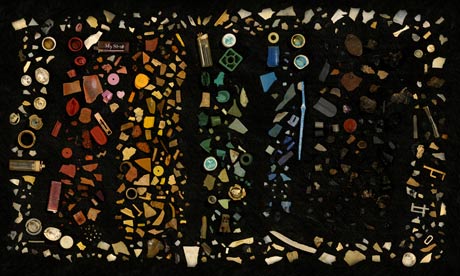
A photo of the contents of an albatross chick's stomach illustrates the impact our dependency on plastic has on marine wildlife.This photograph shows plastic found in the stomach from the carcass of a Laysan Albatross fledgling. Collected and arranged by Dr Cynthia Vanderlip, Division of Forestry and Wildlife, Hawaii. Photograph: Rebecca Hosking/Philosophical Transactions of the Royal Society Toothbrushes, bottle tops and cigarette lighters – all every day objects we take for granted. But as this startling picture taken of the contents of a young albatross shows, some of the 260m tonnes of plastic used annually ends up in the most unlikely places. Sometimes with tragic consequences. Published this week in the Theme Issue of Philosophical Transactions of the Royal Society, the picture clearly illustrates the impact our dependency on plastic has on marine wildlife. The special issue took two years to compile and contains contributions from more than 60 scientists worldwide to provide the most comprehensive description of the consequences of our use of plastics.Dr Richard Thompson from Plymouth University who edited the special issue said it should be a research priority to find out what effect swallowing plastics has on the 160 species of marine wildlife that swallow it. "Plastic production is growing at 9% a year," he says. "The quantity of plastic produced in he first 10 years of this century is likely to approach the quantity produced in the entire century that preceded it."The contents from the dead Laysan albatross chick were collected and arranged by Cynthia Vanderlip on Kure Atoll in Hawaii. The photograph was taken by Rebecca Hosking, who successfully campaigned to turn her hometown of Modbury plastic bag free. It is not known whether the bird died because it ingested so much debris, and it is often difficult to establish whether plastics kill marine life. "For ethical reasons you can only carry out this research on dead birds – so it's difficult to establish exactly how they've died," says Thompson.guardian.co.uk
No comments:
Post a Comment